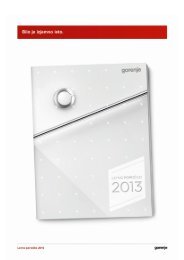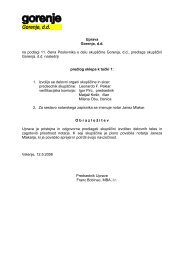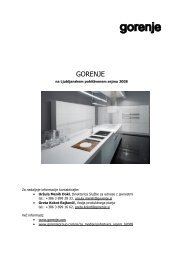ANNUAL REPORT 2008 - Gorenje Group
ANNUAL REPORT 2008 - Gorenje Group
ANNUAL REPORT 2008 - Gorenje Group
You also want an ePaper? Increase the reach of your titles
YUMPU automatically turns print PDFs into web optimized ePapers that Google loves.
147<br />
and work in progress, cost includes an appropriate share of production overheads based on normal<br />
operating capacity.<br />
Net realisable value is the estimated selling price in the ordinary course of business, less the estimated<br />
costs of completion and selling expenses.<br />
(i) Impairment<br />
(i) Financial assets<br />
A financial asset is assessed at each reporting date to determine whether there is any objective<br />
evidence that it is impaired. A financial asset is considered to be impaired if objective evidence<br />
indicates that one or more events have had a negative effect on the estimated future cash flows<br />
of that asset.<br />
An impairment loss in respect of a financial asset measured at amortised cost is calculated as the<br />
difference between its carrying amount, and the present value of the estimated future cash flows<br />
discounted at the original effective interest rate. An impairment loss in respect of an available-forsale<br />
financial asset is calculated by reference to its fair value.<br />
Significant financial assets are tested for impairment on an individual basis. The remaining financial<br />
assets are assessed collectively in groups that share similar credit risk characteristics.<br />
All impairment losses are recognised in profit or loss. Any cumulative loss in respect of an available-for-sale<br />
financial asset recognised previously in equity is transferred to profit or loss.<br />
An impairment loss is reversed if the reversal can be related objectively to an event occurring after<br />
the impairment loss was recognised. For financial assets measured at amortised cost and<br />
available-for-sale financial assets that are debt securities, the reversal is recognised in profit or<br />
loss. For available-for-sale financial assets that are equity securities, the reversal is recognised directly<br />
in equity.<br />
(ii) Non-financial assets<br />
The carrying amounts of the Company’s non-financial assets, other than investment property, inventories<br />
and deferred tax assets, are reviewed at each reporting date to determine whether there<br />
is any indication of impairment. If any such indication exists, then the asset’s recoverable amount is<br />
estimated. For goodwill and intangible assets that have indefinite lives or that are not yet available<br />
for use, the recoverable amount is estimated annually at the reporting date.<br />
The recoverable amount of an asset or cash-generating unit is the greater of its value in use and its<br />
fair value less costs to sell. In assessing value in use, the estimated future cash flows are discounted<br />
to their present value using a pre-tax discount rate that reflects current market assessments of the<br />
time value of money and the risks specific to the asset. For the purpose of impairment testing, assets<br />
are grouped together into the smallest group of assets that generates cash inflows from continuing<br />
use that are largely independent of the cash inflows of other assets or groups of assets (the<br />
“cash-generating unit”). The goodwill acquired in a business combination, for the purpose of impairment<br />
testing, is allocated to cash-generating units that are expected to benefit from the synergies<br />
of the combination.<br />
An impairment loss is recognised if the carrying amount of an asset or its cash-generating unit exceeds<br />
its estimated recoverable amount. Impairment losses are recognised in profit or loss. Impairment<br />
losses recognised in respect of cash-generating units are allocated first to reduce the carrying<br />
amount of any goodwill allocated to the units and then to reduce the carrying amount of the<br />
other assets in the unit (group of units) on a pro rata basis.<br />
An impairment loss in respect of goodwill is not reversed. In respect of other assets, impairment<br />
losses recognised in prior periods are assessed at each reporting date for any indications that the<br />
loss has decreased or no longer exists. An impairment loss is reversed if there has been a change

















